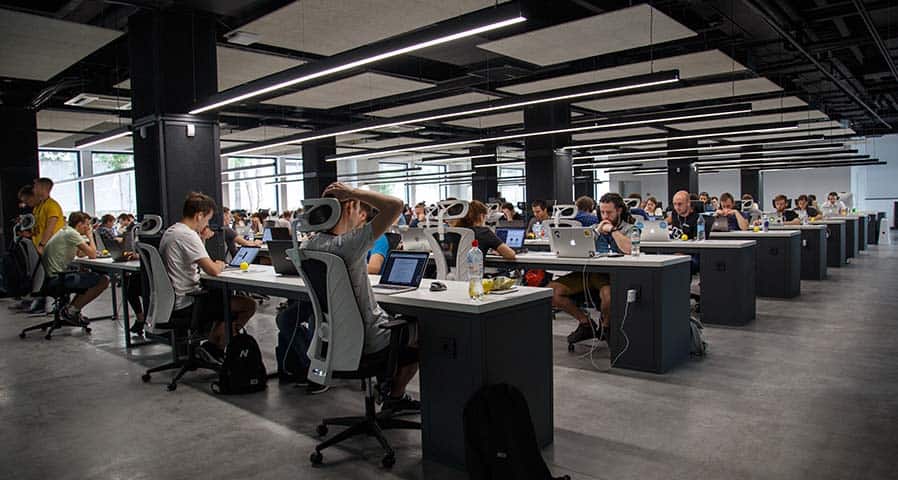Daylighting Controls & Daylight Savings: Optimizing Natural Light Through the…
Studies have shown that natural lighting has proven to improve workplaces by helping employees be more…

This was originally published December 1, 2022, and was rewritten June 19, 2025.
Lighting is one of the most underestimated tools in the modern workplace. While its primary purpose may be illumination, lighting design profoundly affects employee productivity, mood, and overall workplace satisfaction. Strategic lighting decisions can transform an average office into a high-performance environment, especially those that consider color correlated temperatures (CCTs), task lighting, and natural circadian rhythms. So, can lighting increase employee productivity?
The value of lighting goes beyond the electric bill. According to the 3/30/300 Rule developed by JLL, for every $3 spent on utilities in a commercial space, companies typically spend $30 on rent and $300 on payroll. Using this formula, a 15,000-square-foot office spending $4.5 million annually on payroll could gain significant savings, up to $225,000, by increasing employee productivity by just 5%. Optimizing your lighting may yield a better return than reducing utility costs or space usage.
Lighting’s impact is deeply rooted in human biology. Color-correlated temperatures, measured in Kelvin, simulate the effects of natural daylight throughout the workday. Cooler, blue-enriched lighting (above 5000K) stimulates mental acuity and alertness, while warmer tones (below 3000K) promote relaxation and wind-down.
A well-planned CCT schedule helps align indoor lighting with the natural day:
Mimicking natural daylight cycles reduces fatigue and regulates employees’ circadian rhythms, improving both energy levels and sleep quality.
Lighting has a psychological impact that can either elevate or suppress mood. Bright, cool light can help reduce symptoms of depression and increase serotonin levels, which is critical for workplace energy and engagement. Dim or poor-quality lighting can lead to eye strain, drowsiness, and even seasonal affective disorder (SAD) symptoms, especially in spaces lacking access to natural light.
Studies have also found that exposure to blue-enriched lighting (up to 17,000K) reduces melatonin levels during the day, making employees feel more alert and improving memory, cognitive performance, and overall happiness.
Effective lighting design requires tailoring light to specific job functions. This is where task lighting comes in. Adjustable desk lamps, cabinet lighting, and under-shelf lights provide direct illumination where needed, helping reduce glare, eye strain, and posture-related fatigue.
For desk-based employees, vertical lighting or indirect ambient light helps create a balanced environment, especially when working on screens. Offering employees control over task lighting, brightness and angle, also improves comfort and, by extension, productivity.
Human-centric lighting controls offer a hybrid approach: automated yet adjustable. These systems can adapt lighting throughout the day, shifting CCTs and intensity based on preset schedules while allowing employees to personalize their environment.
Conference rooms, brainstorming areas, and quiet zones benefit from adjustable presets:
Installing dimmers on ambient and task lighting adds another level of flexibility, helping each employee find their ideal lighting setup.
Lighting is more than ambiance, it’s about supporting human biology and behavior. By using dynamic lighting systems that follow natural light patterns, companies can help regulate employees’ sleep cycles, decrease stress, and foster a more creative and productive workplace. Studies from design experts and firms like HOK have shown that access to natural daylight and personal control over lighting are major contributors to employee satisfaction and perceived productivity.
While energy-efficient LEDs provide cost savings, the thoughtful lighting application leads to measurable productivity gains. Incorporating color-correlated temperatures, implementing task-specific lighting, and integrating lighting controls create a workspace where employees can thrive physically, emotionally, and professionally.
If you’re looking to reduce overhead while increasing output, the lighting in your building may be the smartest place to start. To learn more about lighting strategies that increase productivity and employee satisfaction, contact our team today at 610-558-9773, email [email protected], or schedule a call to speak with one of our lighting specialists.